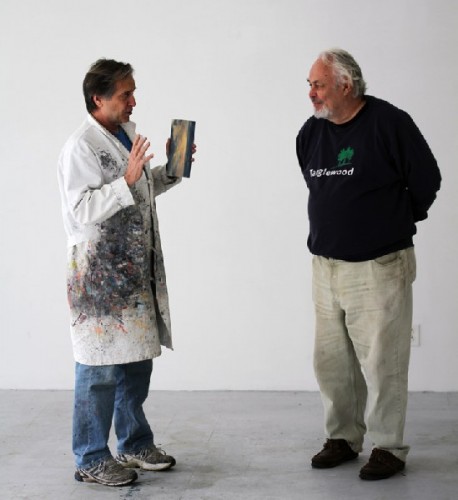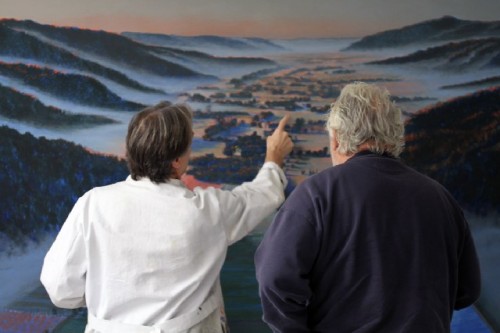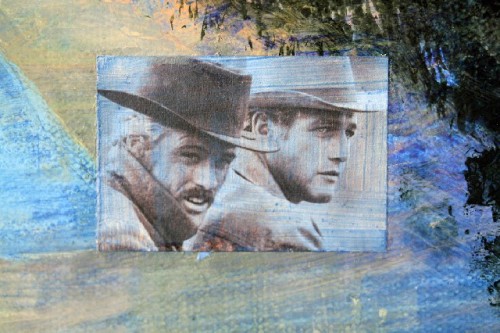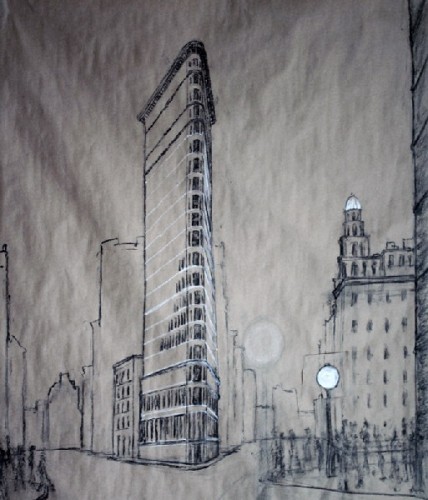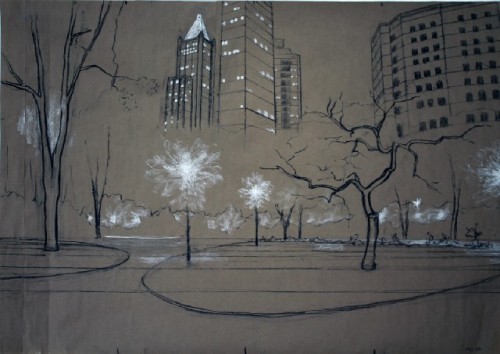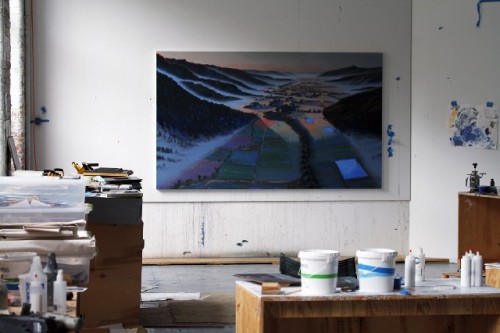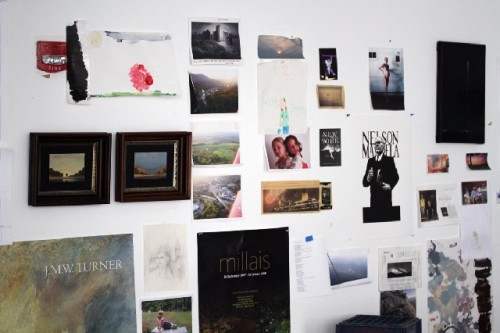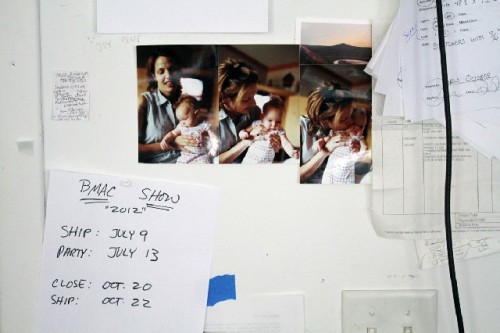Artist Stephen Hannock Part Two
Dreamscapes Biopic at Williamstown Film Festival
By: Charles Giuliano and Stephen Hannock - Oct 14, 2012
Charles Giuliano How did the film Dreamscapes come about?
Stephen Hannock Wolfram Hissen is a German filmmaker who lives in Normandy with his wife and three kids. I met him twenty five years ago when he had a friend in common with the guy who manages my studio in New York. I met him then and he was doing work for Christo. He started to film exclusively for Christo and Jeanne Claude.
He was going through the Met one day and saw my painting “The Oxbow.” This is before they had both pieces up. The other one is “Kaaterskill Falls.” He saw that and tried to find out how to track me down. He said “Let’s do a movie.” I said “Knock yourself out.” He followed me around for three years. He raised the money himself.
CG How much?
SH I have no idea. Probably about $100,000.
CG So it’s an Indie. How did he shoot? Film or video?
SH Hi-def video. Right Dave?
David Lachman Yeah. Most of the budget went for flying around the world.
SH And the lighting. Wait till you see where we are. He said we have to go to this restaurant in Venice. He intercepted me during my annual trip to Tuscany. Where Sting and I figure out all the problems in the world. (Laughing) What are we going to tackle this year?
He said you have to come through Venice. I said I would love to because that year the Venice Biennale was going on. But also a show by John Wesley was there. I love his work. He had a huge show in one of the pavilions.
CG He’s a quirky artist. Why do you like him? We saw a lot of his work in the Chinati Foundation in Marfa, Texas.
SH Right. He’s an old buddy of Donald Judd.
CG There was an entire building with his work.
SH I bet it’s the same show.
CG No, that’s a permanent installation at Chinati.
SH We got to the show and it was closed for the whole month of August. We couldn’t believe it.
CG That’s Italy.
SH We went through the Biennale and not one of the pavilions had any moving air. There weren’t that many people there in August. If the place was packed it would have been suffocating. In the American Pavillion half of Bruce Nauman’s installation was broken down. He would have been furious if he saw this thing. The whole thing (Biennale) was poorly maintained.
Then we went to this restaurant on the top of a building and we got shots up there overlooking the canal at twilight. He just whipped it out. If he had scheduled that shoot it would have cost a hundred grand. He just did it renegade.
CG On 60 Minutes last week there was the story about an obscure musician from Detroit Sixto Rodriguez. A Swedish filmmaker (Malik Bendjelloul) shot the film Searching for Sugar Man on his iPhone. He went broke during post production but the unfinished film went to Sundance.
SH Francis Coppola said it fifteen years ago “Somebody is going to win the Academy Award for a film that costs five thousand bucks.” Of course he was speaking with outrageous hyperbole. It’s almost literally right on the button now. It’s much the way that it exists with computer graphics. Somebody is typing away and the thing spits out something with a picture on it. That person then says “I’m a graphic designer.” Well, no. There’s more to it than that. Clearly the same thing exists here.
Wolfram would say “Where are you going next?” I answered here and there. I’m going to Newcastle to unveil a painting. He just timed it to intersect me at all these different places. After two years he sat down and said “Let’s see what sort of film we have?”
I had no influence on the film. I had no idea of what he was trying to do.
CG What’s the point of the film? What does it say about you?
SH You’ve got me. I have no idea. It’s pretty strange where you’re doing paintings ripping into them and writing on them. He captures how my living life is woven into these paintings.
CG Is that true?
SH Absolutely.
CG You have a remarkable lifestyle. Friends with Sting. Fly all over the world. On every possible VIP list. Have vast studio space. Show at Marlborough. Have you sold a painting for seven figures?
SH (Smile and long pause) I have to stay out of that. I can’t tell you who the players are. There’s something going on. But I get a fraction of that.
CG PB&J?
SH They (Marlborough Gallery) pay for everything. I used to pay for what they pay for now. Let me tell you. It’s a good deal.
CG Traditionally, the split between artist and gallery is fifty/ fifty.
SH I haven’t done that in awhile. I’ve been doing 70/ 30.
CG Seventy for who?
SH Me. That’s not where it is with Marlborough now. But when you see what they cover in terms of shipping, promotion. These things (paintings) are sold before I can finish them. There were only four paintings in the Marlborough show (last year) but they’re monsters. They will be sold when the deals are hammered out. The big ones are all going to public collections. One I’m holding out for the London show.
(By e mail Stephen commented that while the large works sell for high prices they may take years to research, develop and finish. Because they are painted entirely by him, and not by a staff of assistants as is the case with mega artists like Damien Hirst and Jeff Koons, only a few epic scaled works leave the studio.)
CG This brings up the issues of passages for artists. At every step there seems to be a threshold. What is the degree of difficulty to sell a show of twenty works for six figures? Then the more limited pool of potential collectors and institutions when a handful of works go for seven figures. It seems that there is ever more fierce competition when one reaches the narrower, higher end of the art market.
SH It’s a crowded arena. I think you would be surprised. The contemporary arena, as you know more than most people, is divided up into different slices. There’s the pop arena. That’s not pop culture. Pop art. It’s fine art but done at the pace at which the contemporary culture is moving. We have friends who are doing that. The artists tend to be not so much hands on who are doing that. They are more like movie producers. Then you get into other arenas like the installation artists. They are a little bit pop but more into architecture. The huge hot slice right now is for large scale photography. They are basically movie sets. Gregory (Crewdson) is my favorite of those artists.
I have an affinity for Jeff Wall because the two of us went into making work that glowed. In the mid seventies. I was going into landscape and I was making them glow. He was using light boxes to make them glow.
As these works become scarcer and much more complex to do they get a lot more expensive. The irony is that my take-home hasn’t changed much at all in the past fifteen years. There are just more players involved. A lot of players involved. That’s just how it is.
CG It seems to reach a point where covering the mega artists moves from the arts and entertainment pages to the business pages. There is less about writing about art and more about covering Wall Street. Can we even consider aesthetics when reviewing an exhibition by Hirst or Koons for example? Their work no longer seems to be driven by aesthetic considerations? Isn’t it time to drive the money lenders out of the temple of art?
SH I’m in a very different realm than those guys. Compared to them I don’t make very many pieces. They have warehouses of work. I have a bunch of assistants. They have assistants who are hired by the assistants. I have two main assistants that run the show here. Dave (Lachman) manages everything else so I can come and do the work. Signe Kutzer, an MCLA grad student, does the work of five of my New York assistants. With their help I get the painting done. Michael Chapman is not on staff but builds all my stretchers. He does all the building stuff that I need to do this. The cases. The crates. Chapman still does work for Mass MoCA and the Williams College Museum. We have a lot of people who are really good up here (Berkshires). I’m able to pay what they deserve. That’s where my money goes.
CG But not at city prices.
SH No. Absolutely not. That’s huge. You should talk to Jenny Holzer. She’s in the same situation. We use Mass MoCA as our studio for trying out certain things. It’s a great facility. My paintings are named after Mass MoCA. Much in the way that the ‘60s New York School numbered their paintings after their studios. Tenth Street number 6. Fourteenth Street number 33. Mass MoCA indicates all the works which were done outside of New York.
Sometime you need to talk to Mark Taylor. He has more of an understanding and an ability to articulate the economics of art on the Wall Street scale. He was a philosophy and religion professor at Williams who writes two books every year. Then Columbia built a department around him. He wrote the introduction to my book. His last book (Refiguring the Spritual: Beuys, Barney, Turrell, Goldsworthy, Religion, Culture and Public Life) is astute about how Wall Street has glommed onto art, not just to art, but bodies of works of art. I just don’t make the objects to be a part of that thing.
I’ve never had a piece come up for auction. It is probably going to happen this year because the prices are going up to the point where some of these guys are going to try to unload them. Then come back and get newer work. I’ve had pieces go at smaller auctions that did well.
Watching Wolfram make this film has been very much like how I go about making my paintings. You find where you want to shoot and what’s the story that comes out of that?
CG You have an interesting context in which the work is seen. When artists have gallery exhibitions, on average every two years, the show is up for a month. You have two works on more or less permanent view at the Met. But you have unique daily exposure to an elite audience dining at the dozen upscale restaurants that display your paintings. That is very different from having works in private collections where they do not get that kind of public access.
SH That’s one of the points that Wolfram makes in the film. First of all, it’s only places owned by Danny Meyer and Tom Colicchio. The Ritz did buy a group of paintings for an installation up there. But the only work I have done specifically for a space has been with Danny and Tom.
There are more curators who pull the trigger after seeing the work in these places, top level restaurants, than in galleries. It has more to do with the fact that galleries are hard sell. Everybody has their guard up. Galleries really want that sale. At restaurants the paintings play second fiddle to the food and the service. I waited on tables and bar tended for years. Peter (architect) and I discuss what we need to do for each space.
CG The film we saw at WFF last year focused on Danny Meyer made a point about the total confluence of all aspects contributing to the dining experience. The restaurant as what the Germans define as Gesamtkunstwerk or a total work of art. It was a term coined by Wagner to describe the totality of his operas. Meyer and Colicchio appear to bring this concept of totality to their designs and execution of restaurants. It is indicative of how we have evolved, and perhaps caught up with the French, by approaching food as a work of art. The restaurant has become the equivalent and as expensive, if not more so, as an orchestra seat at the Metropolitan Opera and, arguably, as dramatic and aesthetically satisfying. American chefs now have the status and celebrity of artists and movie stars.
SH That was Danny and Tom’s breakthrough. In a nutshell. They understood that. They understood how important that was. So, instead of taking this piece or that piece, they said, go talk to this guy. Find out where the walls are going to be. Peter describes the vibe he is trying to out together and it’s brilliant. I was quite pleased to see that Wikipedia got that. There was an article in W some years ago about how that was put together. It was a breakthrough.

